Success with no-tillage — a radical change in farming from conventional methods — came thanks to the vision, courage and dogged determination shared by many — and from every corner imaginable.
Ingenuity and an “against the grain” perseverance are omnipresent in the “no-till story.” From the testing and perfecting of new chemical formulations … to the researchers and extension agents who ignored their bosses and tirelessly studied the practice … to the salesmen who quelled their doubts upon hearing one “no” after another … to those who created the forums, associations, workshops and field days.
But most important are the farmers themselves, who constructed their own farm-shop innovations, subjected themselves to ridicule for their “ugly, lazy ways of farming,” faithfully stuck with an unproven practice and worked the problems out. Farmers’ willingness to share successes and failures were priceless in transferring know-how to the next curious farmer. Competition, ego and embarrassment were set aside for the greater good.
1830
- 250-300 labor hours are required to produce 5 acres of wheat with a walking plow, harrow, hand broadcast of seed, sickle and flail.
1837
- Blacksmith John Deere fashions a broken steel saw blade to a highly-polished moldboard from which sticky prairie soils easily slide off while turning under the furrow. He and Leonard Andrus start manufacturing steel plows in Grand Detour, Ill., before separating into different plow companies 10 years later.
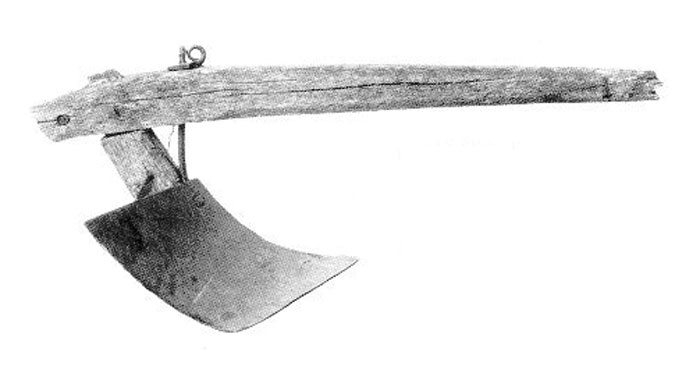
“Imagine how different things would have been for agriculture had John Deere been a chemist instead of a blacksmith? And instead of inventing a self-scouring steel plow, he’d invented Roundup …” — Randall Reeder, Retired Extension Agricultural Engineer, Ohio State Univ.
1862-75
- Change from hand work to horses characterizes the first American agricultural revolution.
1905
- USDA sends plant explorer Frank Meyer to China to look for interesting seeds. He sends back thousands of seeds, cuttings and whole plants, including 44 varieties of soybeans.
1926
- Irish mechanic Harry Ferguson patents the three-point linkage for farm tractors in Britain.
1928
- H.H. Bennett and William Ridgely Chapline release the USDA bulletin, Soil Erosion: A National Menace. Bennett will go on to be recognized as the “father of soil conservation.” Bennett asks: “What would be the feeling of this Nation should a foreign nation suddenly enter the U.S. and destroy 90,000 acres of land, as erosion has been allowed to do in a single county?”
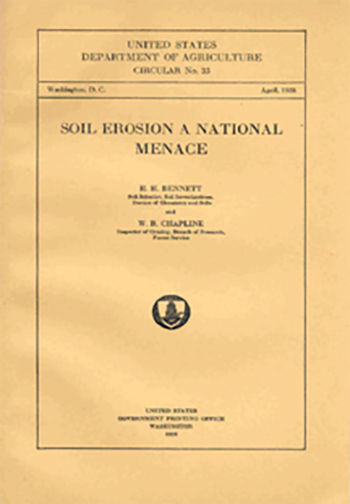
- Guy Swanson’s great-grandfather in Wash. direct-seeds winter wheat into harvested pea ground left barren by stationary thrashers and steam engines. “It showed the possibilities of no-till, but it’ll be another 50 years before continuous no-till settles in the area,” Swanson says.
1930
- 15% of U.S. farms have adopted the tractor.
- U.S. emerges as a major soybean producer, passing Japan in 1931 and Korea in 1934.
1932
- Shell Chemical pioneers the use of ammonia as a fertilizer, first in irrigation water and in 1939 for direct soil applications.
1934
- The Illinois Agricultural Experiment Station establishes its Dixon Springs substation and will become a major contributor to no-till research.
- Dr. H.H. Bennett, the “father of soil conservation,” delivers a highly publicized testimony on soil conservation. With a dust storm traveling from the bare fields of the Great Plains all the way to Washington, D.C., Bennett stalls his testimony until the dust clouds darken the sky over the U.S. Capitol. The Senate unanimously passes legislation to create the Soil Conservation Service (SCS), a permanent agency under USDA, Bennett heads until retiring in 1951.
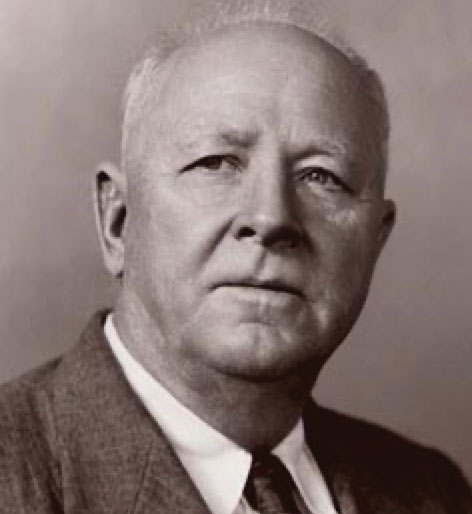
- The National Soil Dynamics Lab is established at Auburn, Ala., as part of USDA’s Ag Research Service. Conceived by Mark Nichols and John Randolph, the full-size laboratory studies the relationship between tillage tools, traction equipment and soil types.
- In response to the extreme soil drifting in Western Canada, Charles Noble develops a system to shear stubble and weeds below the ground and leave the residue on top of the soil to reduce evaporation and prevent erosion.
- Agronomists Frank Duley and Jouette Russell at the Univ. of Nebraska, along with SCS scientists, begin research into conservation tillage to control wind erosion and manage crop residue.
1941
- Spurred by a wartime need for domestic sources of fats, oils and meal, the U.S. doubles soybean production from 1941 to 1942, passing both Manchuria and China to become the world's leading soybean producing nation, a lead maintained ever since.
- Henry Ford envisions a world in which more or less everything would be made of soy, including cars and clothing. The $39,000 “soybean suit” that Ford proudly donned in 1941 was only one-quarter soy fiber, though (the rest was wool). Soy fabrics proved impractical, and most of the other non-food soy uses envisioned by Ford and others in the 1930s and 1940s never panned out.
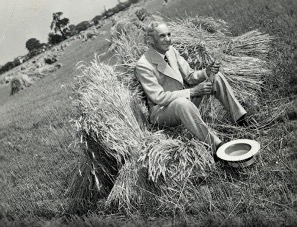
1943
-
Plowman’s Folly, authored by Edward H. Faulkner (an ag agent in Ohio), is released. “No one has ever advanced a scientific reason for plowing,” the book asserts. “The hottest farming argument since the tractor first challenged the horse was started by Faulkner's attack on the moldboard plow,” reports Time Magazine in its coverage of Faulkner vs. Walter T. Jack debate, an Iowa farmer, plow proponent and author of The Furrow and Us. Faulkner’s idea that seeds can be planted directly into residues from the previous crop motivates a soil conservation movement in the U.S. that would eventually take the form of no-till.


1944
- Purdue Univ. conducts the first row-crop tillage-planting experiments for leaving crop residue on the surface of the soil to control erosion. Project is initiated by ag engineer R.R. Poyner and agronomist Helmut Kohnke, both of Purdue, and USDA’s R.B. Hickok.
- Leonard Fleischer develops the first ridge-till equipment and establishes Fleischer Mfg. in Neb.
1945
- The amount of tractor power overtakes horsepower for the first time on U.S. farms.
- At the end of World War II, Dow releases 2,4-D to control broadleaf weeds, presenting the first real possibility of cultivating crops without tillage.

1947
- Iowa farmer Ray Hagie invents the first self-propelled sprayer. This development would prove key to no-tillers who needed timely application on ever-increasing acreages.
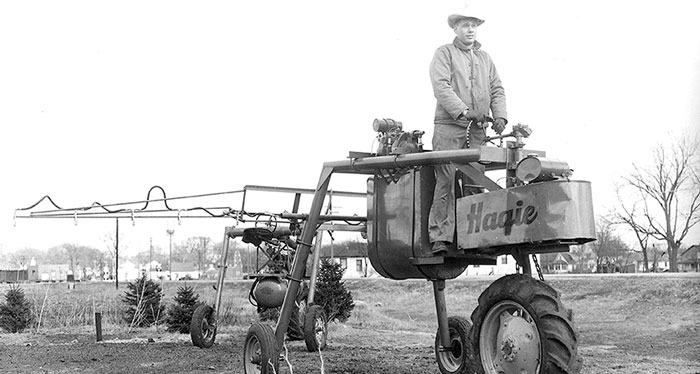
1948
- Colorado farmer Frank Zybach invents center pivot irrigation. His “Self-Propelled Sprinkling Irrigating Apparatus” (patented in 1952) system consists of sprinklers attached to arms that radiate from a water-filled hub out to motorized wheeled towers in the field and eliminates moving pipes by hand. Valmont Industries buys the patent in 1953.
1951
- K.C. Barrons and his team of researchers at Dow Chemical report on the successful application of no-tillage techniques.
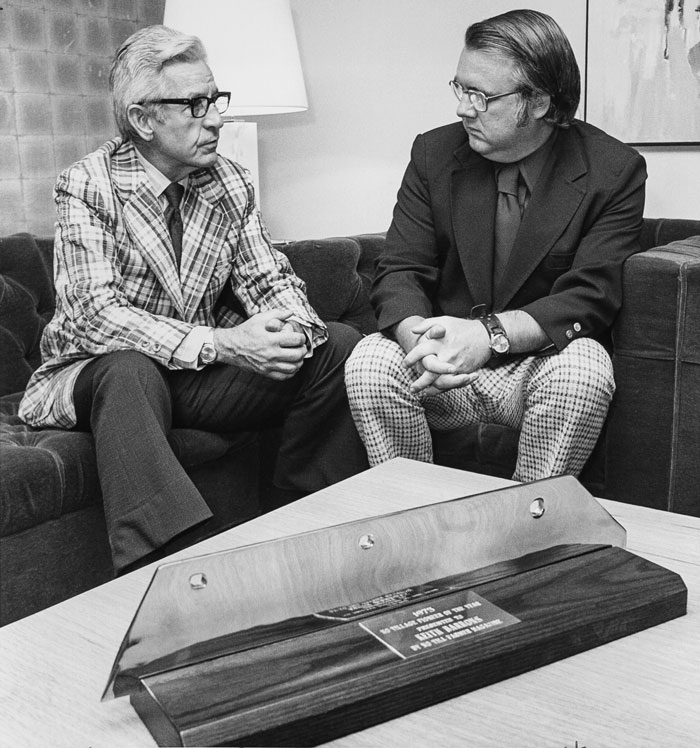
1953
- Based on R.R. Poyner’s patent, IH produces the first commercial no-till planter, the McCormick M-21 (2 rows on 40-inch spacing) at its Richmond, Ind., plant. The lack of weed control products at the time thwarts its success, and IH ceases production after 2 years. Only 23 of 50 units produced were sold.
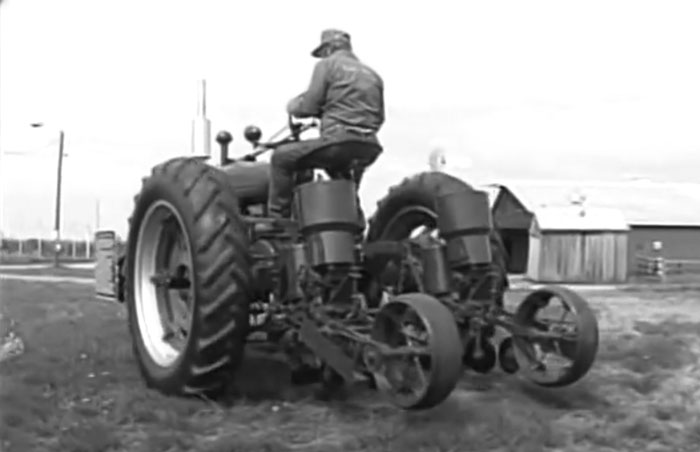
1954
- The number of tractors on farms exceeds the number horses and mules for the first time.
1955
- The invention of the herbicide paraquat in the U.K. starts the modern no-tillage development in Europe and worldwide. This discovery leads the Imperial Chemical Co. to initiate research into farming without tillage.
-
The “Grassland Drill” is refined by Mississippi State Univ. engineers and produced by Taylor Machine Works, Louisville, Miss., and John Deere. According to then grad student Glover Triplett, it cut a slit in the bermudagrass pasture and deposited seed. It was called “sod seeding.”
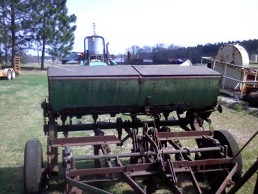
1956
- South Australian company Gyral, founded by Albert Fuss, introduces the air seeder in response to farmers who were unable to plant in more compact soil environments. The lightweight seeder was mounted on a Graham Holme chisel plow.
- Anhydrous ammonia is increasingly used as a cheap source of nitrogen, boosting yields.
1958
- Atrazine is registered in 1958 by Ciba-Geigy for weed control in corn. It will be used extensively in the U.S. by the early 1960s.
1960
- Monsanto establishes an Agricultural Division.
1961
- Stauffer Chemical Co. patents glyphosate as a descaling and metal chelating agent, unaware of its use for its agricultural division.
- Univ. of Illinois agronomist George McKibben establishes plots in Dixon Springs, Ill., to begin no-till research in an effort to reform farming techniques during the production revolution.
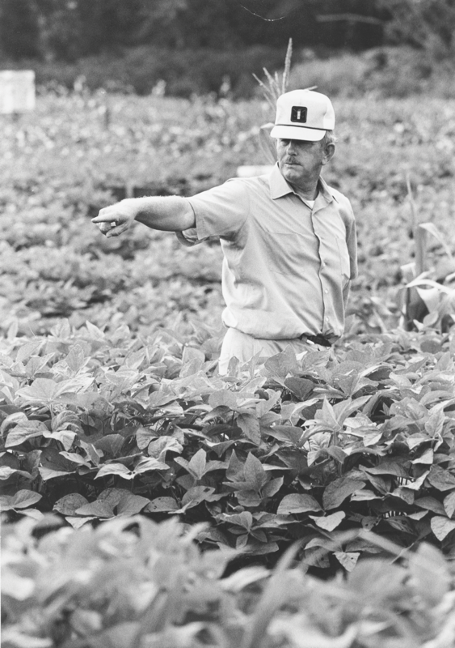
- John and Jake Kirschman build the original SpraCoupe sprayer in their N.D. workshop, with features that outperform tractor-mounted spray booms in numerous ways. Rights and design are later purchased by Melroe, Clark Equipment, Ingersoll Rand and then AGCO.
1962
- Harry Young is the first in the U.S. to use no-till on commercial farmland. He modifies a mule-drawn 2-row planter to no-till corn on a highly visible 0.7 acre plot in Herndon, Ky.
- Ohio State Univ. (OSU) establishes plots in Wooster to determine how much, if any, tillage is needed to obtain satisfactory crop yields. They are continuously operated and known today as The Triplett-Van Doren No-Tillage Experimental Plots. At the 2003 dedication of the OSU Triplett-Van Doren No-Tillage Experimental Plots are (from L): OSU alum Bill Richards, Glover Triplett, David Van Doren and Bobby Moser, ag college dean.
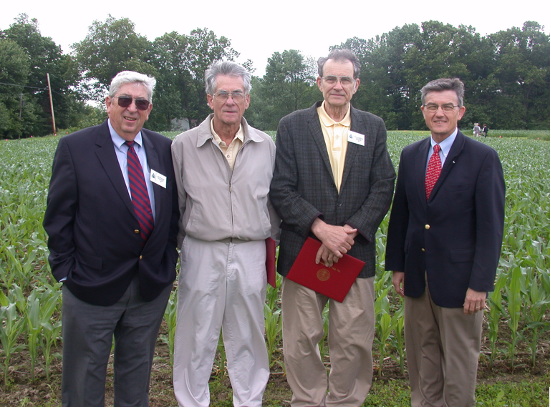
- With West Tennessee farmers losing 40 tons of soil per acre annually, the Univ. of Tennessee AgResearch and Education Center at Milan opens.
- John Kirkpatrick, a Haywood County, N.C., dairy farmer, also plants a no-till corn crop into old fescue sod. A state monument is erected in 2005.

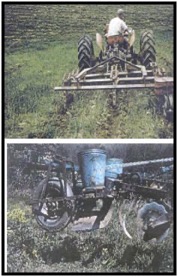
-
Dicamba (first described in 1958 and patent acquired by Versicol Chemical) is approved for use in the U.S.
1963
- Ky. farmer Eugene Keeton demonstrates the finger pick-up seed meter for planters and sells the design to John Deere.
1964
- Banvel herbicide (containing dicamba) is registered by the USDA.
1966
- Chevron Chemical releases paraquat in the U.S. for use as a burndown herbicide and to eliminate weedy plants in wheat fields.&
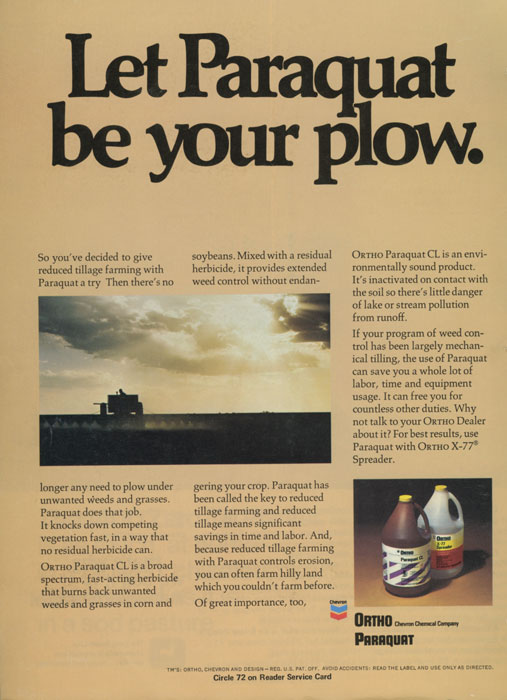
- Donnie Morris, an ag mechanic at the Univ. of Illinois’ Dixon Springs Ag Center, designs a 3-row no-till planter. The “Sod and Stubble Planter” was pitched to John Deere, but wasn’t pursued due to insect control concerns. (Illinois Farmer Today)
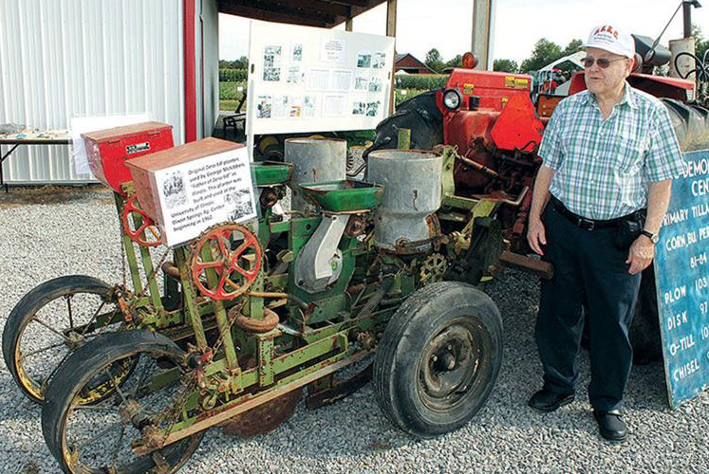
1967
- Allis-Chalmers introduces the first fluted-coulter no-till planter, the first commercially sold unit to find success.
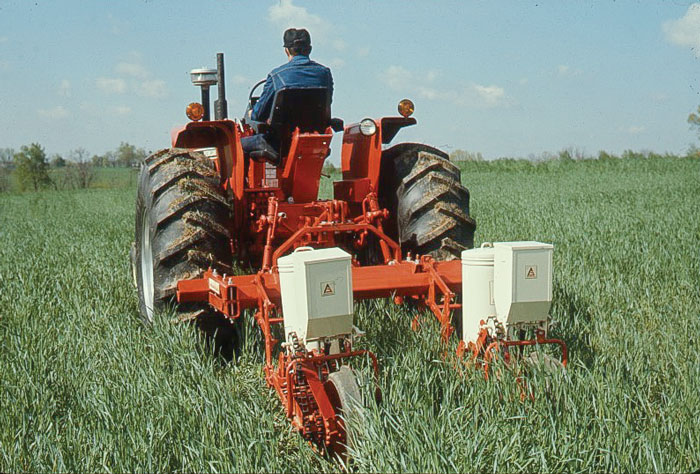

- No-till soybeans start to be double-cropped after wheat. Soybeans lend themselves easily to no-till planting, especially for beginners.
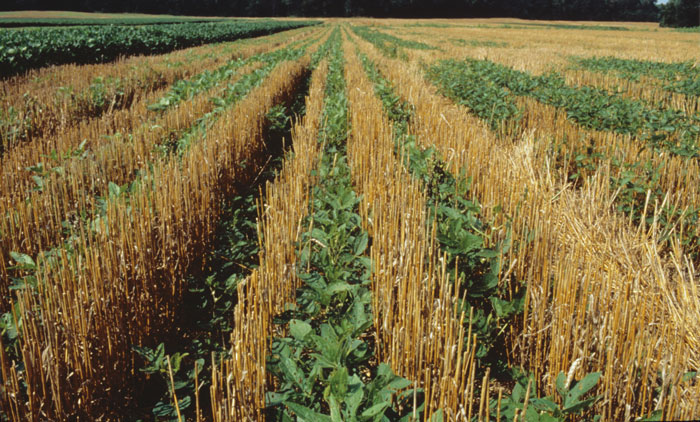
- The No-Till Tillage Practices Survey (released in 1969) reports that Ky. led all states in 1967 with 150,000 no-till acres. That figure is 4 times as large as the next nearest states of Tenn. (35,000 acres) and N.C. (30,000 acres).
“I was determined that we didn’t need to plow and could do things in one pass. We tried the Western lister in the late 1950s and ’60s, before the coulter came along. In those early days, I was just trying to buy the parts we needed. We went to the John Deere factory, and they snubbed us, but International Harvester and Ralph Baumheckel of IH’s Product Planning Group opened the doors for us. Ralph let me roam around the IH planter factory and pick out whatever we wanted. I’d say it was a breakthrough because Ralph followed up on what we were doing. He believed the discontinued IH Poyner Till Planter was a real innovation and that no-till concept would work.” – Early Ohio no-tiller Bill Richards.
1968
- The commercialization of Monsanto's Lasso herbicide is credited with beginning a trend toward reduced-tillage farming.
1969
- OSU researchers Glover Triplett and David Van Doren find mulch-covered no-till soils reduce surface evaporation, maintain soil moisture and create a favorable environment for root development.
1970
- UK soil scientist Bob Blevins starts no-till plots at the Univ. of Kentucky’s Spindletop Research Farm in Lexington. Longtime Univ. of Missouri professor C.M. Woodruff establishes a continuous corn no-till plot at the UM’s Sanborn Field. It’s believed to be the oldest continuing no-till plot west of the Mississippi River. Along with Ohio State Univ. (1962), these two plots are among only a few sites worldwide that have been continuously no-tilled for 50-plus years.
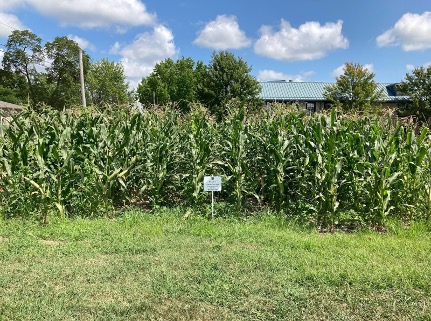
UM Sanborn Plots.
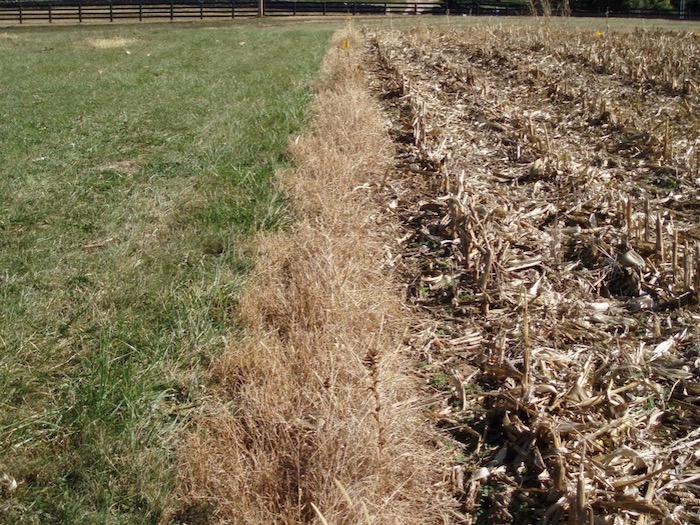
UK Spindletop Research Farm.
- At the request of Monsanto's Dr. Phil Hamm who was excited about two compounds studied in water softeners, recently transferred chemist John E. Franz studies herbicidal use and discovers the weed-killing properties of glyphosate, an application that had not been recognized by Stauffer Chemicals a decade earlier when it was patented as a metal chelator. The third compound Franz synthesized (glyphosate) would become the active ingredient in the original Roundup formulation that would change the face of farming.
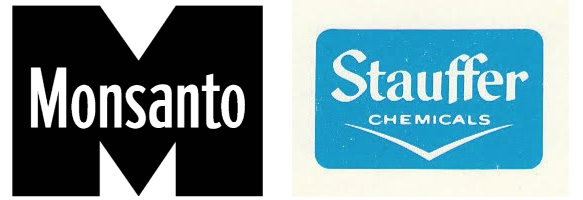

John Franz
1972
- Frank Lessiter edits and produces the first edition of No-Till Farmer (No-Till Farmer) while at Reiman Publications. This is the first and only remaining publication today devoted entirely to no-tillage farming.
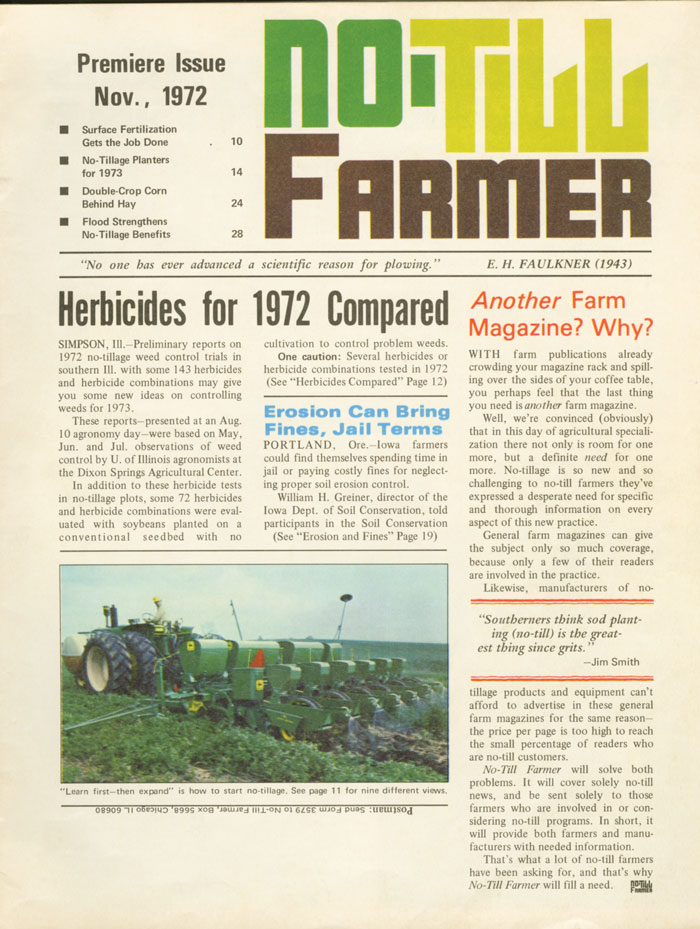
- A SCS agronomist says it will take 118 years at the present rate of adoption to install all of the needed terraces on Indiana farms. The same amount of land conservation could be accomplished in a 1-year period via the adoption of no-tillage, he adds.
- Planting of U.S. no-till crops is estimated at 3.3 million acres, according to the first survey of its kind published by No-Till Farmer.
1973
- Ky. no-till pioneers Harry Young Jr. and S.H. Phillips are honored at the first national no-till meeting in Hawaii. They are the first recipients of No-Till Farmer’s Repurposed Plowshare Awards that will recognize 25 outstanding farmers, educators and pioneers from 1973-1981. Among the participants at that inaugural gathering, and making one of his first-ever presentations, was Ohio no-tiller Bill Richards, who’d go on to lead the Soil Conservation in Washington in the 1990s.
- OSU researcher Glover Triplett suggests a classification system for tillage after recognizing differences in crop response to no-till on different soils.
-
No-Till Farmer publishes No-Tillage Farming, a 224-page book by Shirley Phillips and Harry Young. Considered a milestone in no-tillage literature worldwide, the book is translated into Portuguese. It has been credited as the first book on no-till agriculture.
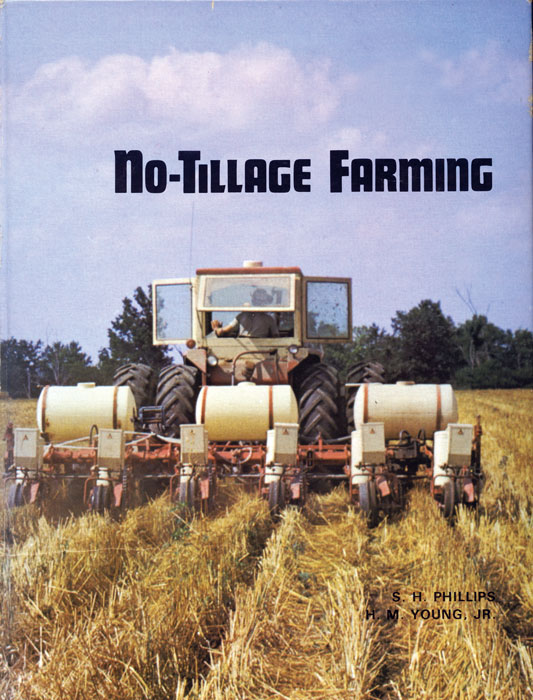
-
No-Till Farmer’s Frank Lessiter testifies before the U.S. House Ag Committee on the importance of no-till to agriculture, and his 1,796 word testimony is entered into the public record.

- Soybean prices spike due to a controversial deal with the U.S.S.R. in 1972 and a decision by President Nixon to temporarily embargo soybean exports in 1973.
- No-till is used on only 1.5% of U.S. cropland.
1974
- Ben Overstreet no-tills his way to a yield of 204 bu. per acre to win the 1973 Georgia corn-growing contest.
- John Deere introduces its MaxEmerge plateless planter with finger-pickup seed metering, Tru-Vee openers and angled closing wheels.
- 5.4 million acres of no-till crops are planted in the U.S.
- A study indicates over 10.5 million acres of Ohio land is suitable for no-till corn production.
- Farmers and researchers evaluate a new John Deere rig with power-driven circular blades as a possible no-till corn or soybean planter.
- USDA predicts no-till will be used on 45% of U.S. planted cropland by 2000, a forecast that would prove far too optimistic.
- One year after its first citation in No-Till Farmer, Monsanto’s Roundup herbicide (glyphosate) is seen by attendees of No-Till Farmer’s Hawaii farm tour. The herbicide will dramatically combat weeds in no-till corn.
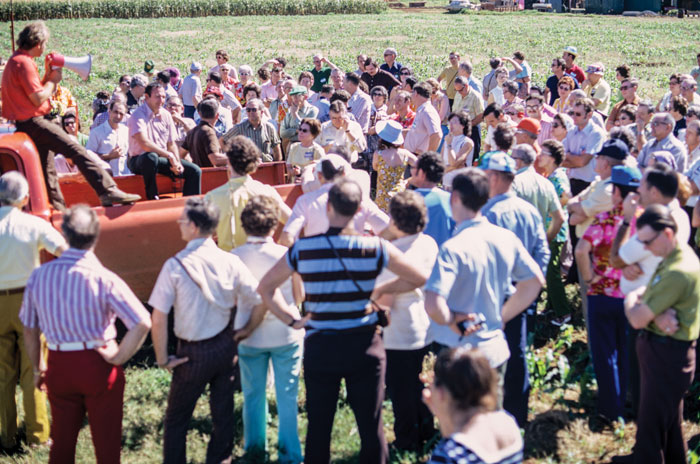
- Western Canadian growers raise a new variety of rapeseed developed by Univ. of Manitoba researchers Keith Downey and Baldur Stefansson that eliminate anti-nutritional components and ensure its safety for human and animal use. The new crop, later known as “canola” (Canada oil), will become the largest source of edible oil in the world and the 3rd largest crop in Canada after wheat and barley.
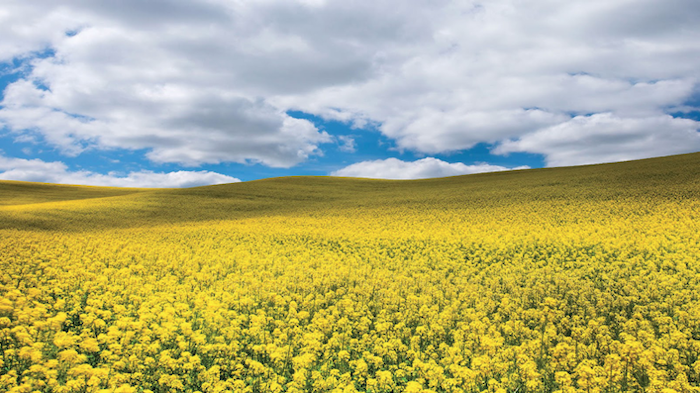
- Mort and Guy Swanson of Wash. build a 29,000-pound no-till drill known as “Old Yeller.” A patent would be filed in 1975. Later, the Swansons team with Mike Johnson and Pete Thomason to build the Comfort King, the first successful no-till drill for the deep Palouse soils of Idaho, Ore., and Wash.
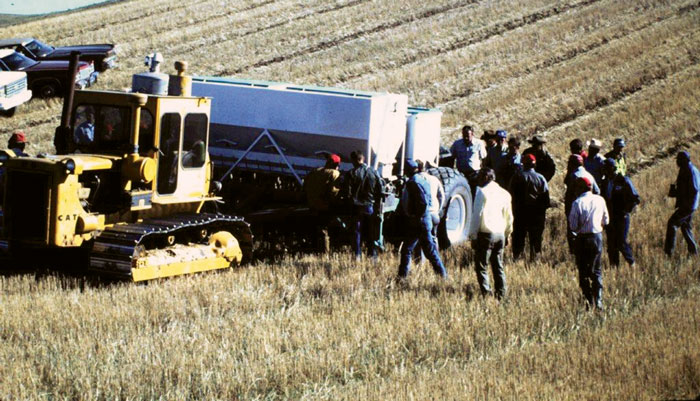
-
BASF introduces Basagran to the U.S. and the no-till soybean acreage expands. Later used in combination with other herbicides, it plays an important role in no-till farming systems in the U.S. and Brazil.
1975
- 3rd annual No-Till Farmer tillage survey shows an 18% increase in no-till acres.
- USDA estimates 95% of U.S. farmland will include reduced tillage by 2010.
- Ohio no-tiller David Brandt imports a Moore seeder from Ireland, the first known no-till drill in the U.S.
- Kinze Mfg. introduces its folding planter technology, leading the way to wider planters that farmers can move down narrow fields and bridges.
1976
- EPA approves Roundup for use in no-till and conventional-tillage systems.
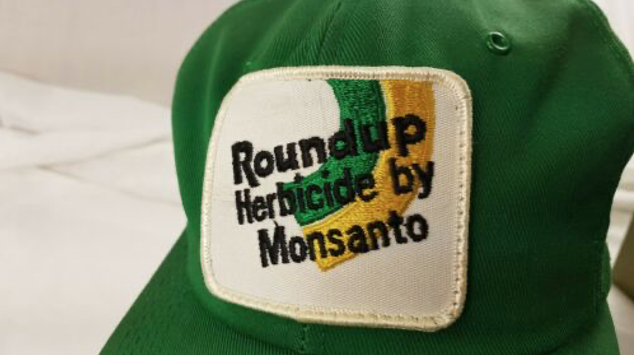
- Kinze introduces its 24-row, rear-fold planter frames, allowing no-tillers like Ohio’s Bill Richards to double planting capacity in one pass. “John Deere was selling planters by the unit at the time, so farmers could put their own planting systems together,” he says. The efficiency achieved from no-tilling with a 60-foot planter would allow Richards to expand up to 8,000 acres in the ’80s.
- Roy Applequist starts Great Plains Mfg. in Salina, Kan. Its first product, a 30-foot folding grain drill, receives its first field test under dryland conditions. Production starts in 1981.
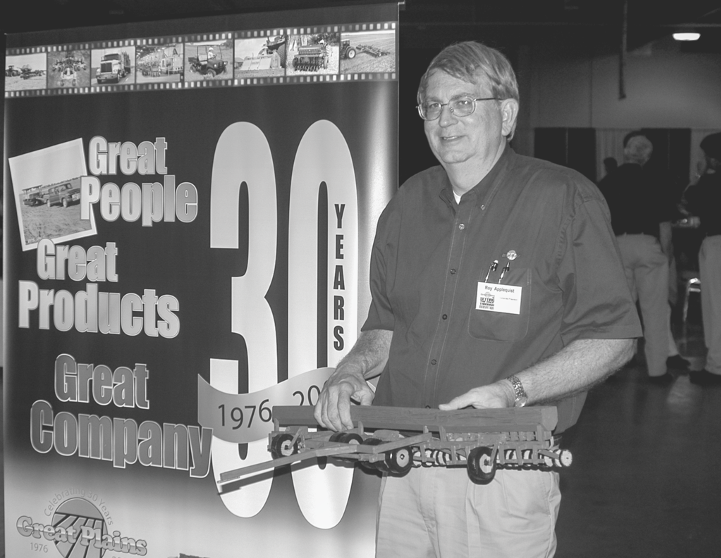
- Melroe’s no-till drill features a triple-disc system that makes direct seeding possible.
1977
- U.S. No-till wheat production jumps to 614,255 acres, compared to 222,833 acres in 1973.
- The Soil and Water Resources Conservation Act of 1977 directs USDA to formulate periodic departmental plans for conservation.
1978
- John Deere introduces its first commercially successful no-till planter, the 7000 series.
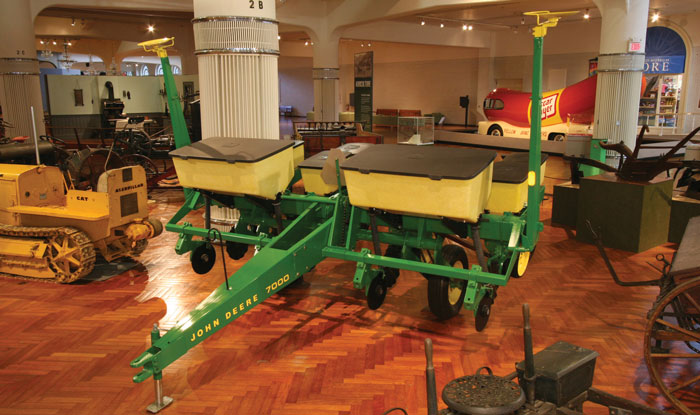
- An invitation-only Zero Tillage Workshop is held in Brandon, Mant., for farmers, researchers, extension workers and manufacturers. A second workshop in 1980 leads to dialog on what would become the Manitoba-North Dakota Zero Tillage Farmers Assn.
1979
- No-Till Farmer publishes an 8-year tillage comparison showing no-till acres increased from 3.3 million acres in 1972 to 7.1 million acres in 1978.
- Raven’s sprayer controller developments bring precision to costly pesticide application.
1980
- “Farmers still cultivate too much,” says U.S. President Jimmy Carter. "They’ve got to go to minimal tillage or zero tillage whenever it’s feasible.”
- IH unveils the Early Riser 800 series planter. Key among no-till features are the staggered double disk openers to more easily cut through residue, the equalizing gauge wheels to reduce row-unit bounce and reduced inner diameter (RID) gauge wheels to prevent sidewall compaction and more easily close the seed trench. The IH unit is marketed as an “as-is” planter for minimum- or no-till, without requiring special attachments.

- Monosem introduces vacuum planters, a new method to accurately place seed at higher, more uniform plant populations.
- Sales of North American farm equipment fall 50% from 1979 as a result of the economic downturn.
- From 1978 to 1980, no-till acres in the U.S. nearly double to 16 million acres.
- Many selective and non-selective herbicides compatible with no-till are produced between 1980 and 1985.
1981
- South American no-till acres reach the same level in 3 years that it took the U.S. 30 years to reach.
- Frank and Pam Lessiter acquire No-Till Farmer and launch a new publishing company in their name.
-
Los Angeles Times runs ‘No Till Farming’ Offers Hope of Cutting Land Loss on June 28, 1981.

- The first Milan (Tenn.) No-Till Field Day at the Univ. of Tennessee AgResearch and Education Center attracts 500 farmers. By 1994, attendance would top 10,000 as farmers from all over the world converge on West Tennessee to learn about no-till.
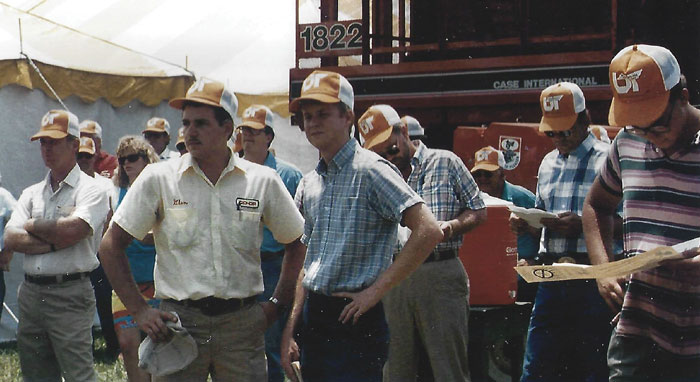
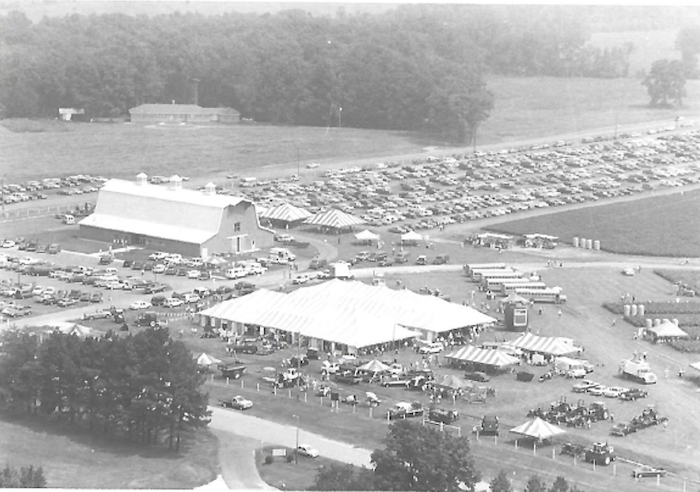
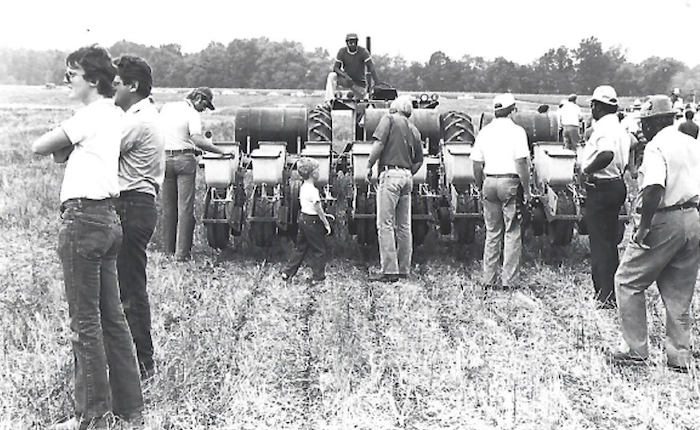
1982
- For the first time, U.S. farmers use reduced-tillage practices on more than 100 million acres of land, compared to 29.6 million acres 10 years earlier.
The New York Times publishes the 1982 article, "Erosion-Wary Farmers are Spurring the Traditional Plow." "I tell farmers they can save soil, toil and oil," says Richard Foell, who promotes herbicides for the Ortho Agricultural Chemical Division of the Chevron Corp. "We’re looking for a 15-25% annual growth rate in no-till acreage. It has an excellent hold in the Northeast. It’s growing the fastest in the Southeast. Ohio, Indiana, Illinois and Michigan are coming along. But in the farm belt west of there, farmers are scraping, ripping, tearing and raping the bosom of Mother Earth."
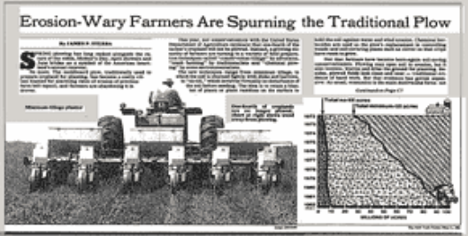
- No-till receives high-level support from Mo. farmer Peter Myers, who serves as Soil Conservation Service chief in President Reagan’s Administration (1982-1989). He admits he’d “botched the no-till practice” in the early 1970s before the machinery and herbicides caught up. Myers became an ardent promoter of no-tillage.

1983
- Kinze Mfg. introduces its “push type” planter row unit. No-tillers quickly take to its Interplant systems, which provides an alternative to grain drills and allows the no-tilling of corn and soybeans at different row widths with one unit.

1984
- U.K.’s adoption of no-till use increases to 605,000 acres, making it second only to the U.S. in no-till acres.
1985
- The 1985 U.S. Farm Bill includes a conservation title for the first time, requiring conservation plans on highly erodible acreage to remain eligible for USDA benefits. It motivates farmers to try no-till, and adoption begins to explode across the plains.
- Burndown herbicide options experience market expansion.
- Conservation tillage is the method of choice for a vast majority of grain farmers.
- John Deere’s release of the 750 no-till drill helps producers switch to no-till and boosts soybean adoption. The innovation is said to have done more for no-till than any other no-till equipment development in history and indicates that John Deere accepts no-till is here to stay.
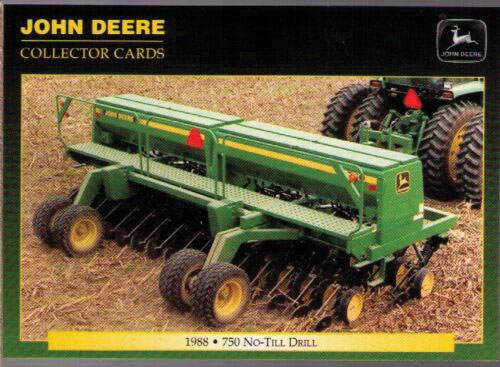
1986
- 20 years of research shows well-drained soils are the key to producing competitive no-till yields.
- No-till acres increase 6.9% over 1985 totals, while minimum-tillage acres drop by 1.4%.
- USDA ag engineers in Temple, Texas, find using no-till in high-clay soils is both possible and profitable.
- Howard Martin of Elkton, Ky., files a patent for the first ground-driven row cleaner. His invention pushes residue aside so soils dry and warm faster for improved stands — and more planting days for no-tillers.
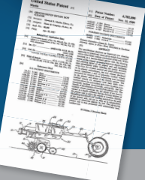
1987
- No-Till Farmer’s “Tillage Practices Survey” shows 2.1 million acres are farmed with ridge-till in 1987 — a 4.2% nationwide increase over the previous year. Ridge till is basically no-till planted on a ridge formed the previous year with 1-2 cultivations.
- Caterpillar starts a trend toward rubber-tracked vehicles, providing another tool to curb compaction and improve field efficiencies on combines, silage harvesters, grain carts and even extra-wide planters and drills.
- Planting of Canola begins in the U.S., 14 years after its introduction in Canada.
“The public, in both the 1985 and 1990 Farm Bills, sent a clear message; it will no longer subsidize practices that erode the soil or damage water quality.” — Bill Richards, Ohio no-tiller and USDA Soil Conservation Chief, 1990-93.
1989
- No-Till Farmer’s 18th Annual “Tillage Practices Survey” shows 17,694 acres of no-tilled cotton.
- About 1.9 million acres of no-till double-cropped soybeans are planted — up from 1.8 million acres in 1988.
- Dow and Eli Lilly form DowElanco, a joint venture to produce agricultural products.
- Displeased with the accuracy of fertilizer placement on his no-till drill, S.D. no-tiller Kevin Anderson files for a patent on a new opener design. The Anderson Opener is based on the premise that fertilizer placement is equally important to seed placement.
1990
- Better and less expensive herbicides begin to hit the market, and no-till equipment continues to improve. Monsanto cut the price of Roundup in the early 1990s at the same time that ag policy is encouraging no-till, leading to the largest increase ever in no-till. By the end of the decade, no-till will grow from 6% of U.S. farmland to nearly 20%.
- U.K.-based Shelbourne-Reynolds sells its first U.S. stripper header in Ky., a significant development for farmers valuing standing residue. Within 5 years, adoption surges as Western wheat belt growers see the benefits of stripped straw in their no-till systems.

- Ohio no-tiller Bill Richards is named chief of the USDA’s Soil Conservation Service (now NRCS) to serve under USDA Ag Sec. Clayton Yeutter and President George H.W. Bush’s Administration. “I’d never had a true off-the farm job but suddenly had 13,000 employees,” says Richards, who championed the no-till movement nationally.
1991
- No-till acreage grows 24% to 17.6 million acres over 2 years.
- CrustBuster’s 3800 no-till drill lets farmers control seed depth independently of rig’s coulters.
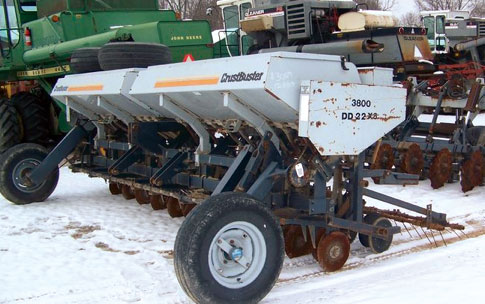
- USDA concerns about residue lead to discussion of possible erosion laws and regulations.
1992
- No-till reaches 22.5 million acres.
- 2,4-D is approved for no-till soybeans after a 30-year wait.
- Trimble introduces real-time kinematic (RTK) technology, advancing precision ag’s prospects.
- Sask. no-tillers Norb and Pat Beaujot develop industry’s first hydraulically activated ground-following individual row-opener on 1,200 acres and a 1-pass seed/fertilizer placement system. The brothers launch a manufacturing company, Seed Hawk. Norb goes on to found SeedMaster in 2002 and DOT (autonomous farming technology) in 2017.
- Capital Agricultural Property Services reports that a “no-till after soybeans and corn” operation requires a machinery investment of $189,600 for 1,000 acres, compared to $270,450 for a “chisel after soybeans, moldboard plow after corn” operation of the same size.
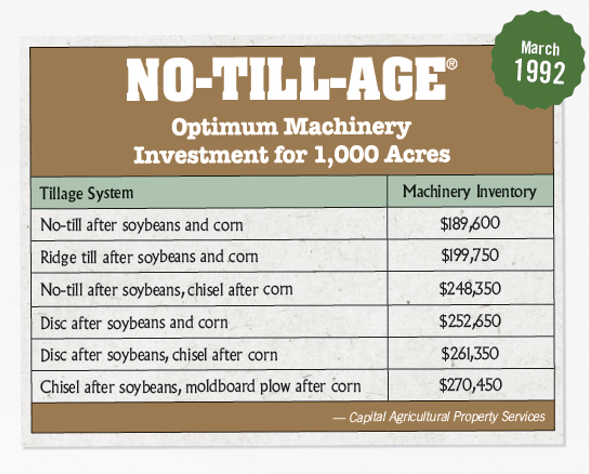
1993
-
No-Till Farmer hosts its first-ever National No-Tillage Conference (National No-Tillage Conference) in Indianapolis with 814 attendees and 45 speakers over 3 days.
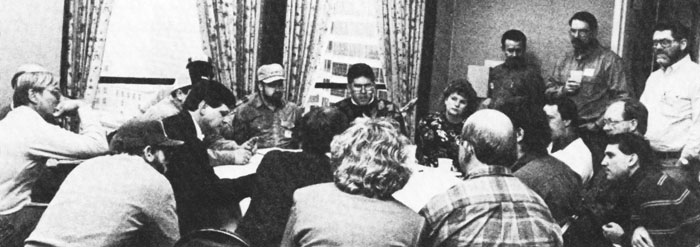

-
Los Angeles Times reports “No-Till: The Venerable Plow May Lose Its Role,” March 23, 1993.
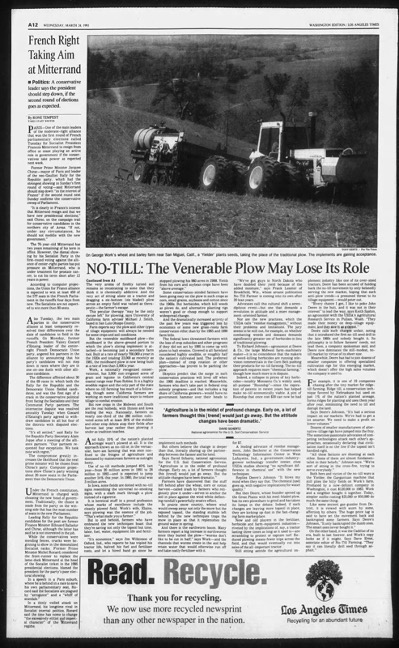
- Illinois farmer Roger Denhart announces plans to no-till 50,000 acres of soybeans in southern Ukraine. Farm managers nix the idea because no-till would put too many residents on collective farms out of work.
- Herb Stam comes out of retirement at age 74 to invent a fertilizer injection knife for no-tillers, the B-33 Mole Knife. His Ill.-based company Hi-Pro Mfg. will earn a No-Till Innovator Business & Service award in 2002 for equipment design.
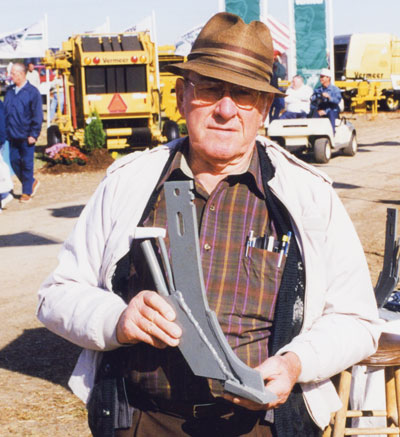
- Sunflower purchases the Best Grain Drill line from Best Mfg. of Jonesboro, Ark., bringing the company into the no-till segment.
- 32 million acres of no-till cropland are reported, a 60% increase from 1991.
- Howard Martin invents and patents the first spiked closing wheel for no-till planters.

- AGCO purchases White-New Idea planters, hay tools and spreaders and its Coldwater, Ohio, facility.
- Kansas-based Landoll Corp. acquires the rights of A-C’s No-Til planter and rebrands it as the Quadra-Planter. Production runs from 1994-2002 before it’s discontinued.
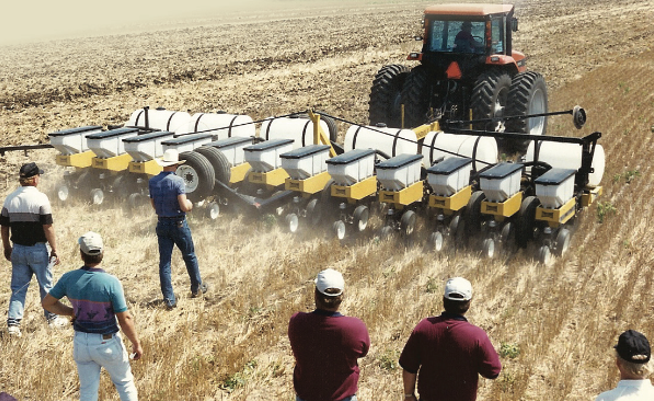
- Glufosinate herbicide, first introduced in Japan 9 years earlier, is registered for use.
1994
- Russia reports success in using no-till to bring back 11 million acres of farmland destroyed by the Chernobyl nuclear power-plant explosion.
- After first attaching duct tape and steel cables to seed tubes in Howard Martin’s Elkton, Ky., farm shop, Eugene Keeton files a patent for his Seed Firmer to maintain seed-to-soil contact in no-till. This “long plastic spoon” from Precision Planting that tucks seeds into the bottom of the seed trench will earn numerous “Reader’s Choice” awards from No-Till Farmer subscribers.
- The precision age begins as farmers use Global Positioning System receivers to determine which areas need specific quantities of water, fertilizer and pesticides. Farmers synthesize this data with yield information, weather forecasts and soil analysis in spreadsheets. Purdue Univ. researchers say adoption of precision technology is the next big step toward efficient no-till farming.
- Pa. no-tiller Steve Groff is the first N.A. farmer to build a cover crop roller, emulating techniques learned from Brazilian no-tillers.
-
No-Till Farmer publishes the The Farmer’s Earthworm Handbook, still its all-time best-seller.
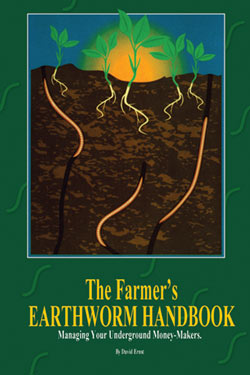
- Martin Industries produces its first floating row cleaner.
1995
- AGCO purchases Tye Co., makers of Glencoe, Tye and Farmhand agricultural implements.
- No-tiller Marion Calmer of Calmer Corn Heads in Alpha, Ill., tests the first 15-inch corn head, leading to the formation of an equipment company in his name.
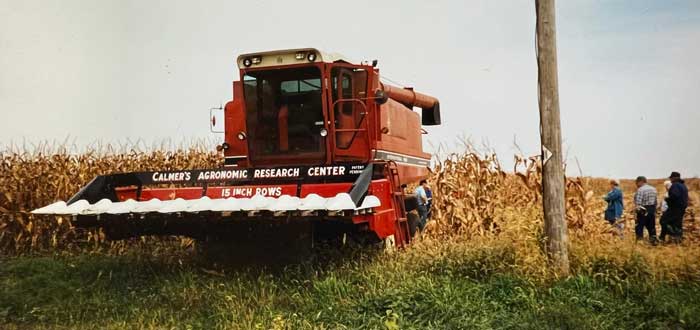
1996
- Monosem introduces twin-row planters, another development toward narrower rows.
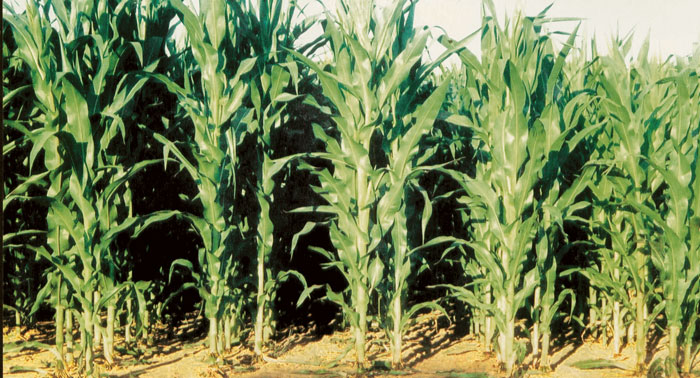
- U.S. no-till acres reach 42.5 million.
- Monsanto introduces Roundup Ready soybeans, spurring greater interest in reduced tillage.
- Howard Martin invents and patents the first spiked closing wheel for no-till planters.
- Roundup Ready Canola is introduced in Canada. “It changed the face of Western Canadian agriculture and was a catalyst in the success of the Canadian canola industry.”
1997
- Monsanto introduces Roundup-Ready soybeans in Canada, providing farmers with in-seed herbicide tolerance to Roundup and other glyphosate-based herbicides. Within the year, Monsanto introduces biotech corn, cotton and canola.
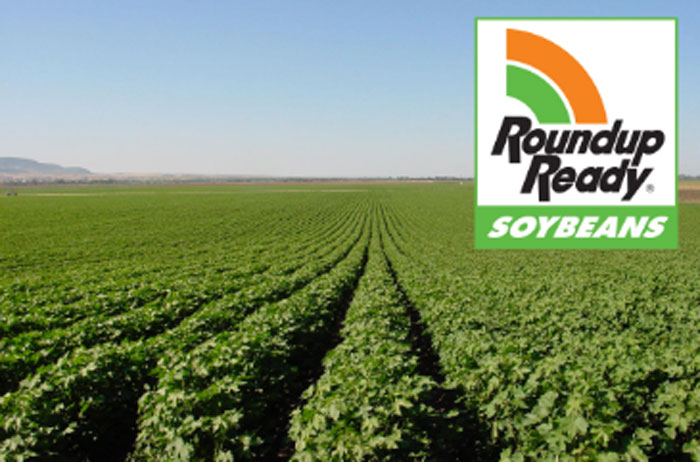
- Studies dealing with the impact of row spacing on cereals and pulse crops over 30 years demonstrate benefits for no-till in western Canada.
- USDA reports soil erosion on U.S. cropland has fallen by 40% since 1982.
- Dow acquires 100% ownership of DowElanco and renames it Dow AgroSciences.
1998
- Southern Illinois Univ. agronomist George Kapusta says Roundup Ready is the “new kid on the block” for no-till soybeans.
- Research indicates ammonium sulfate can be an effective source of nitrogen, particularly with no-till corn.
- Matt Hagny launches Exapta Solutions with the vision of providing better tools for no-till seeding.
- AGCO purchases the Spra-Coupe and Willmar sprayer brands, and merges production in Willmar, Minn.
1999
- No-tillers gear up to sell carbon credits after studies show tillage releases up to 8,000 pounds of CO2/acre into the atmosphere each year.
- DuPont becomes 100% owner of Pioneer.
- Iowa’s Ag Spectrum trademarks its Nu-Till System that combines a reengineered no-till planter with promise of better nutrition and soil- and water-handling characteristics. It features special trash wheels, a seed firmer, closing wheels and nitrogen-banding mechanism.
2000
- U.S. no-till acres are estimated at 50 million.
- Four Wash. no-tillers form an LLC to share a no-till single drill and alleviate the financial burden of each buying bigger equipment.
- The U.S. EPA places new restrictions on raising Bt Corn, requiring a 20% refuge area with non-Bt hybrids.
2001
- AGCO acquires Ag-Chem Equipment Co., Inc., giving it a leading position in self-propelled sprayers.
2002
- Jeff Moyer of the Rodale Institute designs the U.S.’ first U.S.-built cover crop roller-crimper with the help of SARE.
- With 55.3 million acres in the U.S., no-till surpasses mulch-till to become the predominant “conservation tillage” method, according to the CTIC. No-till and conservation tillage practices grow from 26.1% of planted acres to 40.7%, while conventional tillage falls from 48.7% to 37.7%.
- AGCO acquires the assets of Sunflower Mfg.
2005
- The 13th National No-Tillage Conference showcases interest in annual ryegrass as a no-till cover crop.
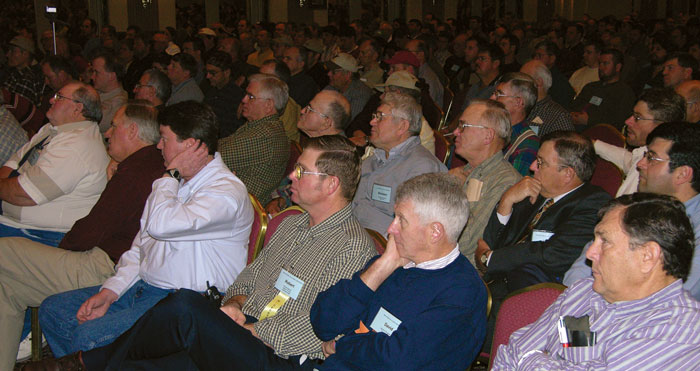
- Environmental and consumer groups question safety of Roundup Ready crops, saying they create “super weeds,” among other problems.
- USDA reports farmers who move from conventional- to no-tillage will save 3.5 gallons of diesel fuel per acre. At 2005 diesel prices, a 1,000-acre farm saves $7,700 in fuel alone.
- Martin Industries releases compact 1360 floating row cleaner, allowing the use of no-till coulters on planters where it was not possible previously due to length.
- According to the USDA, no-till fields have an average of 540,000 earthworms per acre, compared to 285,000 in conventionally tilled fields.
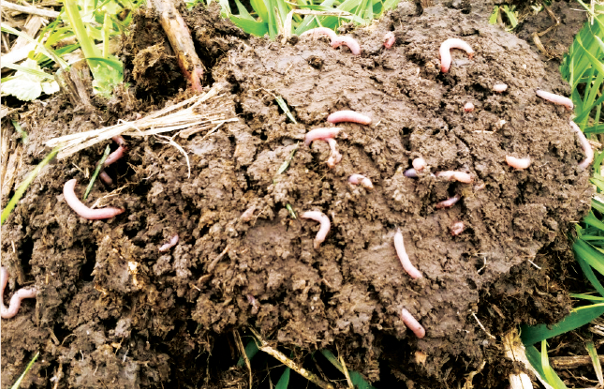
2006
- Research results from the U.S. Dept. of Energy’s Oak Ridge National Laboratory describe the great potential for biomass — specifically gathered from no-till farms — to fuel cars and trucks in the U.S.
- OSU soil scientist Warren Dick says gypsum applications on no-till fields can decrease surface crusting and improve aeration and water infiltration, aiding crop emergence.
- Australia’s David Trevilyan speaks at the National No-Tillage Conference about his 120-foot Multiplanter no-till seeder that earned him a world record of seeding 2,337 acres in 24 hours. Four years later, his company will build a 212-foot frame for another grower.

-
No-Till Farmer launches a magazine-format that subscribers receive quarterly, allowing longer-form content and more in-depth coverage of new products specifically developed for no-till.
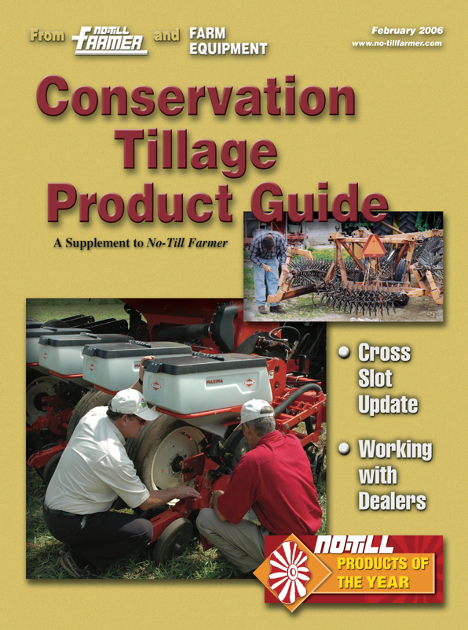
2007
- Glyphosate-resistant horseweed, or marestail, is found in 16 states.
- 3.6 million acres of corn is strip-tilled — 19% of no-till corn acres. It’s basically no-till on 6-8-inch-tall berms built the previous fall or in the spring.
2008
- The percentage of acres containing either Roundup Ready or LibertyLink corn grew from 30% in 2005 to 60% in 2007.
- Oilseed radishes hold great promise as a cover crop.
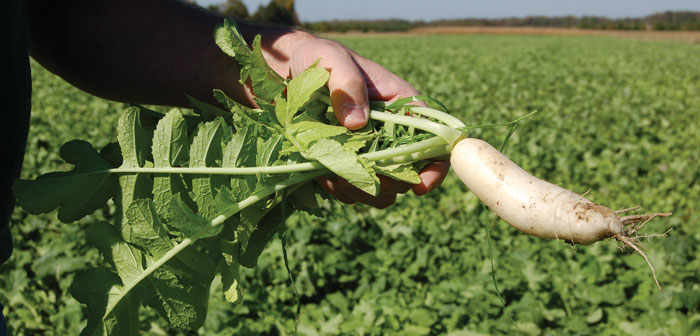
- Martin Industries unit-mounted fertilizer opener, combined with floating row cleaner, receives U.S. patent.
- Paraguay’s Rolf Derpsch determines that there are 232.8 million acres of no-till worldwide, including 88.2 million acres in North America.
- Wayne Lindwall, retired Agriculture Canada director general for environmental health, receives Canada’s highest recognition for a public servant from the Prime Minister for career-long contributions to no-till and carbon sequestration.
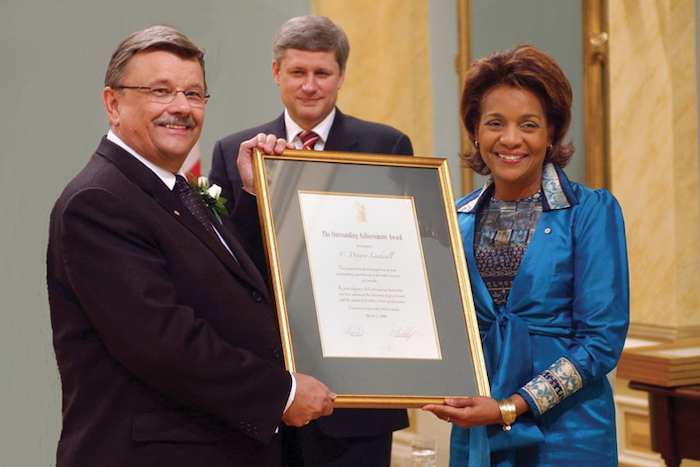
2010
- USDA says 35% of U.S. cropland (88 million acres) was no-tilled in 2009. This includes barley, corn, cotton, oats, rice, sorghum, soybeans and wheat acres.
- USDA says no-till could play a role in U.S. efforts to reduce and control greenhouse gas emissions.
- The President’s Cancer Panel expresses concern over use of atrazine, nitrogen and phosphate due to possible health impacts.
- Va. farmer David Hula, wins the first of several National Corn Growers Assn. (NCGA) yield contests at 368.4 bushels per acre in the no-till irrigated category.
- No-tiller and philanthropist Howard G. Buffett provides a memorable banquet speech at the National No-Tillage Conference in Des Moines on no-till’s role in feeding the world. “We’re growing 70% more corn per 1 pound of fertilizer than we did in the 1970s,” he says.
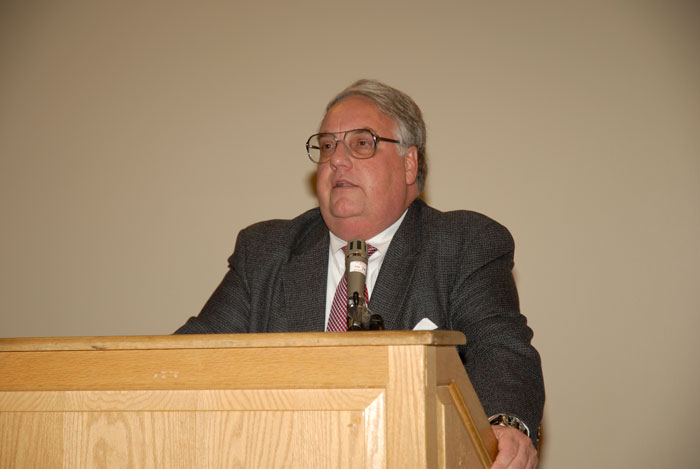
2011
- The Chicago Climate Exchange, which ran the only national carbon-trading market in the U.S., scales back its operations.
- The 19th annual National No-Tillage Conference attracts 867 growers, crop consultants and ag educators, a record crowd for the Cincinnati location.
- No-tillers find that planting winter wheat with oilseed radishes boosts no-till wheat yields by as much as 18 bushels per acre.
2012
- 96 million acres no-tilled — 35% of U.S. total crop acres.
- The American Society of Business Publication Editors (ASBPE) honors No-Till Farmer with the Gold Award (first place) for editorial excellence in the organization’s national contest for newsletters.
- No-Till Farmer publishes an in-depth story on using drones for a variety of farming tasks to improve efficiency and effectiveness of scouting programs.
- Monsanto purchases Precision Planting for $210 million. It will buy Climate Corp. the following year for $1.1 billion.
2013
- No-tillage and cover crops receive major play in U.S. newspapers and magazines. Headlines like “No-till farming is on the rise. That’s actually a big deal,” appear in the Washington Post.
- ASBPE honors No-Till Farmer with the Gold Award (first place) for editorial excellence for the second year in a row in the national newsletter contest.
- AGCO launches Fuse Technologies to provide mixed-fleet-farming operations with improved connectivity to farm data.
2014
- No-Till Farmer launches Dryland No-Tiller e-newsletter specifically for Great Plains, Pacific Northwest and Western Canada no-tillers.
- The Buffett Foundation and USDA hold a national cover crops workshop. Key influencers discuss how to push the acreage seeded to cover crops to 20 million acres by 2020.
- South America reports the highest adoption of no-tillage worldwide. Nations with highest adoption are Argentina (80%), Brazil (50%), Paraguay (90%) and Uruguay (82%). Argentina reports soil erosion reductions of 80%, cost reductions of 50% and increased farm incomes. Brazil reports no-till resulted in reduction of soil erosion losses by 97%, higher farm productivity and income increases of 57% 5 years after the start of no-till farming. Paraguay reports net farm income increased by 77% after adoption of no-till farming.
- Indigo Agriculture is founded. The company builds technological solutions for farmers by developing crops capable of surviving climate change. Later, the company launches a carbon farming program.
2015
- 73% of no-tillers seed cover crops.
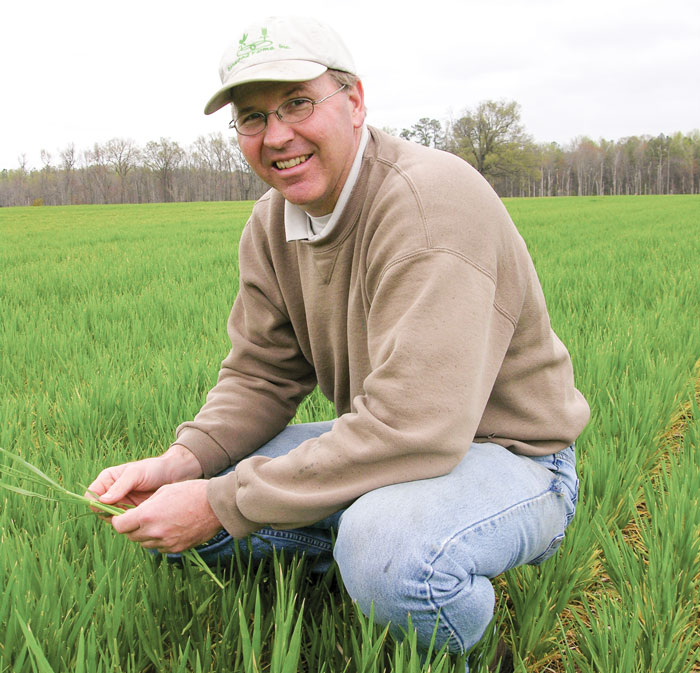
- The National No-Tillage Conference in Indianapolis draws a still-standing record of 1,171 attendees.
- The Samuel Roberts Noble Foundation and Farm Foundation launch the Soil Health Institute (SHI) to serve as the primary resource for soil health information, working to set soil-health standards and measurement, build knowledge about the economics of soil health, offer educational programs and coordinate research in all aspects of soil and soil health.
- The South Dakota Soil Health Coalition is formed with plans for improving the health and productivity of South Dakota soils.
- Deere & Co. and The Climate Corp., a subsidiary of Monsanto Co., sign agreements for Deere to acquire the Precision Planting equipment business. The U.S. Justice Dept. files a lawsuit the following year to block the sale.
- Dow and DuPont announce a definitive agreement under which the companies will merge, then subsequently spin off into three independent companies.
2016
- John Deere acquires majority ownership of Hagie Mfg.
- La Crosse Seed announces it owns the entire portfolio of brands previously used by Cover Crop Solutions.
- 9% of total U.S. crop acres seeded to cover crops, up from 4% in 2005 and 1% in 2006.
- Growers in the 8th annual No-Till Farmer Benchmark Study report a farm average of 1,146 acres.
- Kubota buys Great Plains Mfg., which got its start in the 1970s in no-till, for $430 million.
- Martin releases its first 2 x 2 x 2 fertilizer opener (DUAL UMO), placing nutrients at seed depth.
- The DC-based Kiplinger Today newsletter lists 10 things Americans will say goodbye to in coming years. In addition to a car’s clutch pedal, dial-up Internet, incandescent light bulbs and metal keys was the moldboard plow (#7). “The practice of turning the soil is dying off.”
- ASBPE honors No-Till Farmer as “Newsletter of the Year,” its top award for editorial excellence, in the organization's annual Azbees Awards.
- Illegal off-label use of dicamba herbicide damages 3.6 million acres of soybeans.
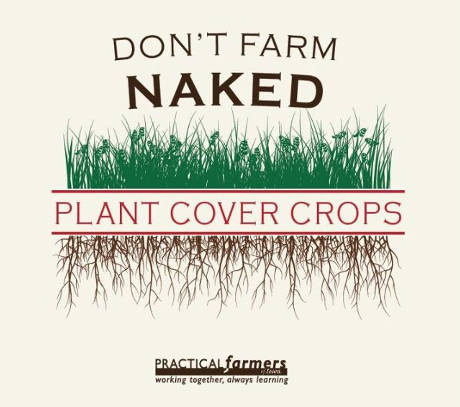
- Syngenta and ChemChina (a Chinese state-owned entity) finalize their merger.
2017
- Illegal off-label use of dicamba herbicide damages 3.6 million acres of soybeans.
- USDA reports that cover crop acres increase 50% from 2012-2017.
- USDA’s National Resources Inventory reports soil erosion on U.S. cropland falls 35%, from 7.1 tons/acre in 1982 to 4.6 tons/acre in 2017. Soil erosion, says Jim Hoorman, Ohio-based soil health specialist, is a key contributor to nitrogen and phosphorus runoff.
- AGCO acquires Precision Planting LLC from The Climate Corp./Monsanto.
2018
- No-tillers Dave Brandt and Gabe Brown, soil health expert Ray Archuleta and grazing consultant Allen Williams form Soil Health Academy and Understanding Ag.
- DLF Pickseed acquires La Crosse Seed.
- Corteva Agriscience, the agriculture division of DowDuPont, brand is unveiled.
- Germany’s Bayer closes on its $63 billion acquisition of Monsanto.
- Martin Industries develops adjustable angle V-style closing update for Case IH 2000 series; develops cupped Razor closing disc for cover crops.
- The 2018 U.S. Farm Bill authorizes the production of hemp.
2019
- David Hula of Virginia takes top position in NCGA national yield contest at 616.19 bu./per acre, setting the all-time record, this time in the strip-till irrigated category.
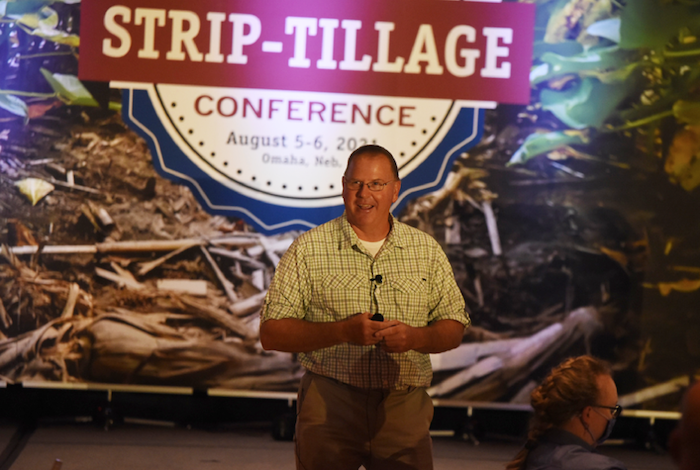
- Packaged food giant General Mills states it will apply regenerative agriculture to 1 million acres by 2030, an amount equal to 25% of the land from which it sources ingredients in North America. Danone, Kellogg, Nestlé and Land O’ Lakes are among others taking similar positions.

- Lessiter Media’s Ag Div. launches Cover Crop Strategies website, e-newsletter and virtual events. Its first-ever National Cover Crop Summit draws 3,000-plus attendees.

- No-tilled acres in the U.S. top 104 million acres in 2017, up 8% over the 2012 figure.
- Acres seeded to cover crops in the U.S. reach 15.3 million acres in 2017, an increase of 49% over the 2012. Average on-farm cover crop acres increased 30% from 77 acres in 2012 to 100 acres in 2017.
- Germany announces it will begin phasing out the use of glyphosate in 2020 and completely ban it by 2023 as part of measures rolled out by the country’s environment ministry to protect insects.
2020
- Cover Crop Innovators from Pa. no-tiller and cover crop expert Steve Groff.
- No-tilling corn in wider 60-inch rows opens room for grazing livestock.
- Cover crops is a hot experimental trend among U.S. no-tillers.
- Indigo Ag and Nori become two of the leading carbon market programs for farmers. Bayer also launches its Carbon Initiative, the latest in a string of recent environmentally focused initiatives by agriculture companies.
- The EPA proposes new measures to reduce risks associated with paraquat and better protect human health and the environment.
- Food company Kellogg commits to phase out the use of glyphosate as a pre-harvest drying agent in its wheat and oat supply chains by 2025.
- OSU soil scientist Rattan Lal (l), pictured with Bill Richards, is announced as the 2020 World Food Prize Laureate for his soil-centric approach to increasing food production that conserves natural resources and mitigates climate change.
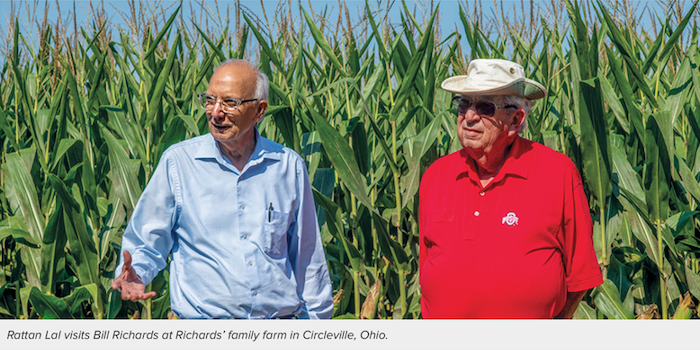
- The Assn. of American Pesticide Control Officials (AAPCO) asks the EPA to ban the post-emergent use of four dicamba herbicides — XtendiMax, Engenia, FeXapan and Tavium — by the end of 2020.
- Exapta Solutions founder Matt Hagny dies during a mountain-climbing accident in Colorado. Management says it’s determined to carry on Hagny’s legacy and continue advancing no-till practices worldwide.
- Corteva Agriscience spins off from DowDuPont, becoming a standalone company.
- A 2020 study of 6 tillage practices for corn at the Univ. of Illinois concludes no-till delivers the lowest average cost per acre, the lowest average power cost per acre and the lowest non-land costs of 6 tillage practices studied.
- Michigan State Univ. completes a 30-year ongoing study of long-term no-till at its Kellogg Biological Station. “Every year for more than 30 years, the yield in no-till treatments increased vs. tilled treatments,” reports MSU Ecologist Nick Haddad. “The findings drive home the importance of long-term studies because they reveal unexpected results. There were many slices of time when we would have gotten the wrong answer if the study had lasted less than 10 years.”
2021
- The 29th annual National No-Tillage Conference is held in virtual format due to the COVID-19 pandemic.
- The National Farmers Union (Canada) releases a study that details that Alberta and Sasketchewan no-till adoption reached 70% in 2016, "and may top 90% this decade." The near-total adoption of no-till by Canadian farmers since 1990 sequestered an estimated 13 million metric tons of CO2 in 2019.
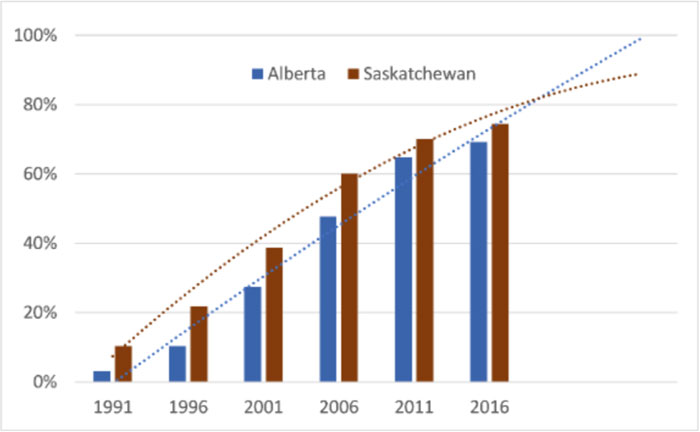
Adoption rates for no-till, Alberta and Saskatchewan, 1991-2016, with trendline projections. Sources: Stats. Can. table 32-10-1062-01
- A 2021 study using satellite imagery, “The Extent of Soil Loss Across the Corn Belt” by Evan Thaler, Issac Larsen and Qian Yu, estimates that about 35% of the Corn Belt has lost most of its topsoil.
- President Biden in his address to Congress says: “When I think about climate change, I think jobs … Farmers planting cover crops so they can reduce carbon dioxide in the air and get paid for doing it.”
- The “Environmental Benefits of Precision Agriculture in the U.S. “ study (AEM, ASA, CropLIfe and TFI) reports “the cultivation of 10.2 million acres of cropland was avoided via more efficient use of existing land, an area equivalent to 4.5 Yellowstone National Parks.” The report also states that 15,000 tons of herbicide have been avoided due to adoption of precision ag technologies such as auto guidance, variable rate and section control.
- No-Till Farmer introduces No-Till Passport, an online feature sharing conservation ag success stories from across the globe.
- Green Cover Seed, headquartered in Bladen, Neb., announces the opening of a second location in Iola, Kan.
- No-Till on the Plains holds its 25th anniversary winter conference.
- A poll of Soil Health Academy graduates reveals the majority are experiencing improvements in their operations’ resources and net per-acre profits within 2 years or less.
- Rodale Institute & Davines Group launch International Regenerative Organic Research & Education Center in Parma, Italy
- After 5 years, the National Corn Growers Assn. shuts down the Soil Health Partnership (SHP) due to lack of funding. The SHP teamed with farmers to collect data on soil conservation practices such as cover crops and reduced tillage.
In the 2021 National Corn Growers Assn. Yield Contest, the top 3 finishers in the no-till irrigated category average 524.39 bu./acre vs. 382.37 for the conventional-irrigated category.
- Herbicide requirements continue to fall. While 10 pounds of herbicide were needed per acre in the early 1960s to make no-till work, farmers are using mere ounces per acre today.
- CNH Industrial acquires Raven Industries.
- Va.’s David Hula cements status as one of the all-time great corn-growers, achieving 602.17 bu./acre in the no-till irrigated category of the National Corn Growers Assn. 2021 Yield Contest. His no-till yields lead all 9 categories in the contest.
- National Corn Growers Assn.’s Contest no-till yields nearly 3 times higher than what the top yielders achieved in the program’s start in 1983.
-
No-Till Farmer starts its 50th year in November 2021.
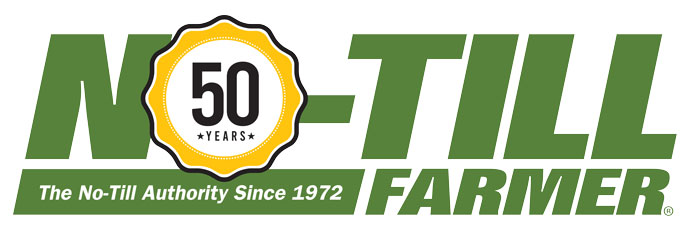
2022
- “Triple Crown of No-Till” celebrated at 2022 NNTC ... 60 years since first no-till plots in Kentucky, 50 years of NTF and 30 years of the NNTC.
- Amir Kassam, Theodor Friedrich and Rolf Derpsch present the Keynote Address at the 8th World Congress on Conservation Agriculture, Bern, Switzerland in 2021, highlighting the nearly half-billion acres of soils saved as a result of no-till/conservation ag.
-
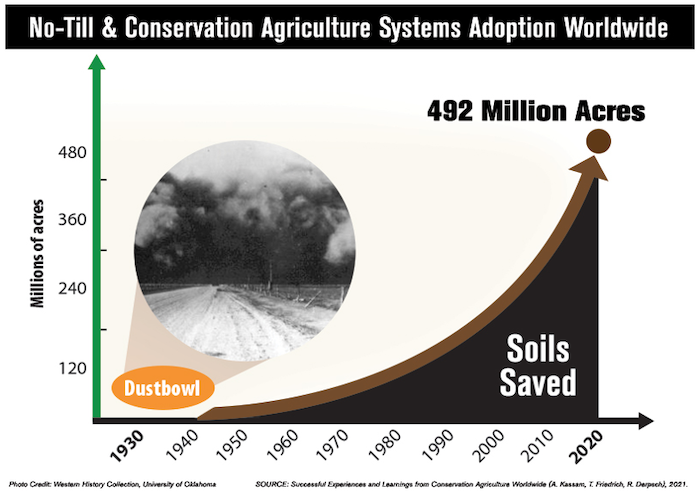
Are we missing an important milestone? Comment below to let us know!
Bookmark this page and check back for future updates.

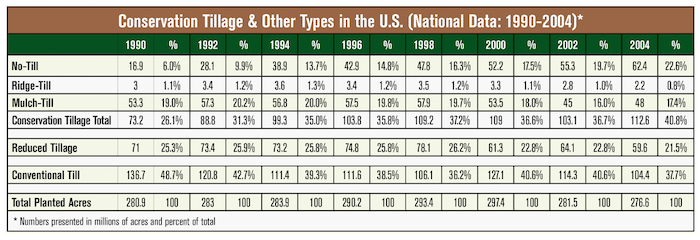


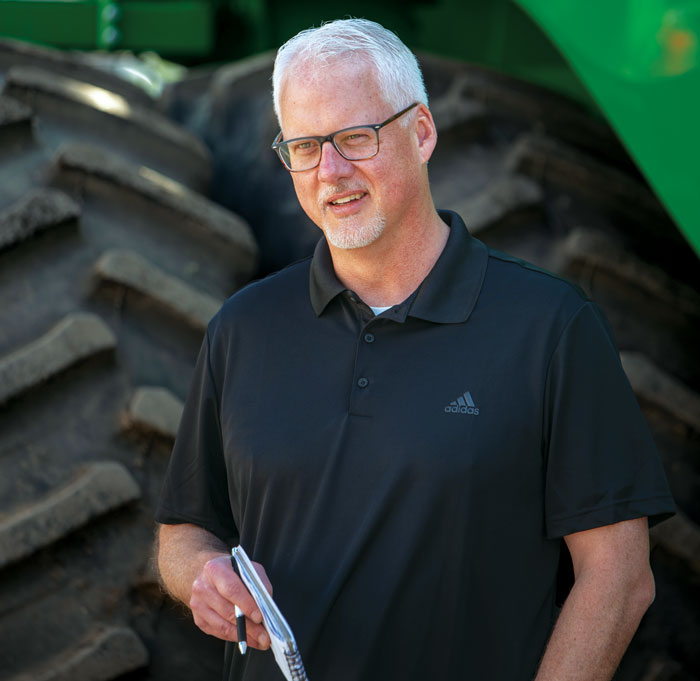

Post a comment
Report Abusive Comment